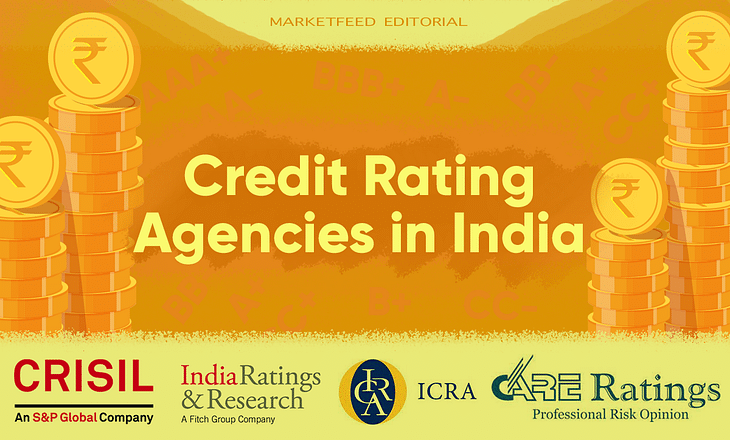How Credit Rating Agencies In India Earn Money

Credit Rating Agencies(CRAs) are generally privately-owned entities that do the job of rating securities like bonds, debentures, shares, and other instruments. Believe it or not, but Credit Rating Agencies(CRAs) seem to be running the show globally.
Standard and Poor(S&P), Moody’s, and Fitch group are known as the ‘Big Three’ and own close to 80% in the international credit rating. Each of the three has a setup in India, that is:
- CRISIL, an S&P Global Company
- India Ratings(Ind-Ra), a wholly-owned subsidiary of Fitch Ratings
- ICRA, a subsidiary of Moody’s
- CARE, not owned by either of the Big Three.
CARE, CRISIL, and ICRA are listed on National Stock Exchange(NSE) and Bombay Stock Exchange(BSE).
CRAs have been controversial for almost half a century. They have been deemed responsible for a few of the many financial or industry crises throughout history; Penn Central Rail Road Crisis and the infamous 2008 Housing Market Crisis to name a few. In India, the IL&FS crisis is said to have taken place due to improper credit ratings.
In this piece, we explore how credit rating agencies make money, what is so special about them and how they perform on Dalal Street.
The Business Model
Broadly speaking, a CRA has three sources of revenue:
- Ratings
- Research
- Advisory
Ratings
Every time a company issues a bond, it has to get rated by a CRA as per norms set by regulatory agencies globally. Based on risk and credit analysis, credit ratings of bonds range from AAA(+/-), AA(+/-), A(+/-) to………. CCC, CC, C D. AAA is considered as the highest grade, and D is considered the lowest grade. If a bond is rated higher, generally it shall receive more buyers in the market since it is less risky. If the bond is rated lower, it shall be deemed risky and generally receive fewer holders.
Every time a company issues a bond, it has to get the bond rated for a price. The rating markets follow the more popular ‘Issuer-Pays Model’ where the issuer or the company issuing the bond pays the CRA to get itself rated. This wasn’t always the case though,
In the 1970s, there was an ‘Investor-Pays Model’ that lost popularity over time, where the buyer of the bond had to actually pay the CRA to access the ratings.
Another major source of income for CRAs is Bank Loan Ratings. Every time a company or an individual borrows money from a bank, a Credit Rating Agency has to rate the borrower based on several factors. Bank refers to the credit report before granting a loan.
Apart from bonds and loans, CRAs have to rate MSMEs, companies, other debt instruments, shares and even the economy of countries. All of these contribute to the revenue stream.
Research
If you have ever gone through a Red Herring Prospectus(RHP) or a report a company files before an IPO, chances are that the report contains research done by a CRA. Banks, companies, and even governments hire credit rating agencies to conduct research on a requirement basis. Sometimes CRAs release reports in the public domain for marketing and maintains their position and reputation in the market.
There have been instances where CRAs have released a negative outlook towards a company or a sector its share price fell on the stock markets. This is how important a research report by a CRA is. A research report by an established CRA gives a clear picture to investors as well as organizations to make well-informed decisions.
Advisory
CRAs have all the data they need in the world. This gives them a better insight into global markets than many businesses. This is why businesses even avail advisory services offered by CRAs. This is done on a contractual basis for the necessary period.
Credit Rating Agencies As An Investment Option
Credit Rating Agencies despite running the show haven’t been running up themselves when it comes to investor returns. Their stocks have caught up only in the past year because of the bull run seen in the Indian markets. Even there, the stocks of ICRA, CRISIL and CARE ratings have barely managed to beat the NIFTY 50 benchmark index. Coming to return on investment for the past one year, CRISIL has returned ~76%, CARE Ratings returned ~69% and ICRA returned ~29%. Even here, the shares did not spike up in one go, rather they moved up in a consolidated manner over a period of time.
The Revenue and Net Profit of CRAs haven’t been consistent for the past three years. This is since CRAs aren’t selling a straightforward product. They are selling an opinion. If their customer doesn’t like it, they can always move on to the rival CRA and get a better rating.
The Big Picture
In 2008, there was a global financial crisis. It all started when CRAs gave a higher rating to bonds with a poor asset or credit quality. They were bribed/incentivized to do so. Yet, there was no action taken against them even after a global downturn.
In India, something similar happened during the IL&FS crisis in 2016. CRAs gave the now failed IL&FS securities a good rating despite knowing of poor asset quality and financial condition of the company. IL&FS did not pay back the money it had borrowed from banks and lenders. Finally, it led to a major credit crunch in the system where banks and financial services companies were hesitant to lend money and the economy remains affected by it even in 2021.
The sector runs in an Oligopoly. Apart from the Big Three, there are only a few independent CRAs, this means that only a few entities get all the business. Barriers to entering the market are high and opportunities are less. Even if the CRAs play foul, SEBI can atmost fine them as they did in the IL&FS crisis in 2016.
In popular opinion, there is rising support for the ‘Regulator Pays Model’ for CRAs where market regulators like SEBI(India) or SEC(USA) would pay the credit rating agencies to rate bonds. The benefit of it could be that CRAs would not play foul or give false ratings to companies. The disadvantage could be that the reports of the CRAs could be influenced by the opinions of the ruling majority or the government.
How do you think we can solve the loopholes in the credit rating industry? What are the growth opportunities for them? Let us know in the comment section in the marketfeed app available on Android and iOS.


Post your comment
No comments to display